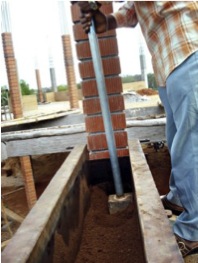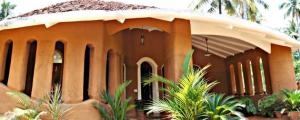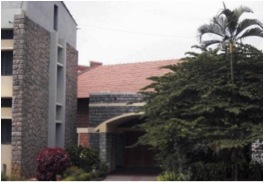Monthly Archives: September 2010
Go for soil cement blocks
They are quite strong and also add character to a building
Simple: The construction process with soil cement blocks is like building with any other block, except taking care of joints and corners
 With reference to mud buildings, though rammed earth has a greater history behind it, building a stabilised mud block (SMB) or soil cement block (SCB) wall is much easier and convincing to a new client. Commonly, mud blocks measure 9”x9”x6” with minor size variations, edge profile and cornice decoration options, as may be required for the project.
With reference to mud buildings, though rammed earth has a greater history behind it, building a stabilised mud block (SMB) or soil cement block (SCB) wall is much easier and convincing to a new client. Commonly, mud blocks measure 9”x9”x6” with minor size variations, edge profile and cornice decoration options, as may be required for the project.
The soil is prepared the same way as for ramming, but here it is packed into the molds within a small machine. The machine comes with a pressing lid, operated by two workers throwing their weight on it, so the soil gets adequately compacted. After compacting, the fresh blocks are lifted out of the machine and kept in the open outside for drying under the sun. All this can be managed within a 60×40 site or even smaller sites if the road sides can be used.
All the three major institutes, viz. ASTRA, Auroville and DA, have developed their own versions of the block making/pressing machine, with the ASTRA model being popular in Bangalore. It is advisable to have three labourers as a team to start making blocks few weeks before the wall construction, get the blocks sun dried and stock up at site. Ideally, the soil dug up from the site itself should be used for blocks, to save on transporting mud from outside.
Testing labs
There are testing labs such as Mrinmayee which can study the sample soil to give advice about the water content and quantity of cement and stone quarry dust to be added to stabilise the soil. However, in case the soil is unfit for blocks or it is in short supply, blocks may have to be ordered from outside.
The construction process is like building with any other block, except for care for joints and corners. Unlike what many people fear about, the SMB wall is not a weaker option! While a normal brick can be cut by the mason using his ‘karni,’ here we need a cutting machine. Even electrical grooves cannot be done by a small chisel and hammer, but once again demand machines. No water can seep through the block, as such external pointing is important only to ensure water-proof joints. The joints with stabilised mud mortar can take any number of nails, a routine household requirement. Of course the joint lines, both horizontal and vertical, are visible in the building, adding a character to it.
Alternately, the wall can be mud-plastered if an even surface without joint break is desirable. It can also be painted with any colour, if the mud looks need to changed. It is interesting to note that a mud building offers the option to completely conceal the mud looks or celebrate the earthy looks, once again scoring over other choices. However, we need not highlight the intentions of using mud construction and what option most owners choose!
Using stabilised mud
Applying traditional mud-based construction methods in modern urban contexts
 We owe the early studies about mud architecture to CRATerre at Grenoble, France, the ASTRA group at Indian Institute of Science, Bangalore, Development Alternates at Delhi and Auroville at Pondicherry. The work at ASTRA during the 70s directly focused on how to apply the traditional mud-based construction methods for modern urban contexts. Very soon, they realised that mud cannot be used directly in its raw state. The process of stabilisation does the magic and the powdery soil becomes hard.
We owe the early studies about mud architecture to CRATerre at Grenoble, France, the ASTRA group at Indian Institute of Science, Bangalore, Development Alternates at Delhi and Auroville at Pondicherry. The work at ASTRA during the 70s directly focused on how to apply the traditional mud-based construction methods for modern urban contexts. Very soon, they realised that mud cannot be used directly in its raw state. The process of stabilisation does the magic and the powdery soil becomes hard.
About this process, I tried to write on my own, but nothing came as good as what K.S. Jagadish, among the early researchers at ASTRA, IISc., wrote in his book ‘Building with stabilised mud’ (I.K. International Publishing, 2007). To quote him, “Since mud is the most widely distributed resource for building construction, it is useful to explore ways of ‘stabilising mud’ without employing energy-intensive techniques like brick burning. Stabilised mud may now be defined as mud which does not soften due to the action of water, by the use of a small quantity of a binding agent. Cement, lime, cement and lime, lime and pozzolona, bitumen and organic binders are some of the typical stabilisers which can be used.
Criterion:The performance of a soil-based building block depends to a large extent on its density
Density factor
The performance of a soil-based building block depends to a considerable extent on its density. Low-density blocks are rather porous and will not have good strength. It is hence necessary to densify soil while making a stabilised block besides adding the stabiliser. For this purpose, the soil has to be subjected to adequate pressure at suitable moisture content. This process is known as ‘compaction’. The compaction can be done inside a machine mould to produce a standard-sized ‘mud block’. Alternately, the soil can be directly compacted in a wall using a moveable mould in what is known as ‘rammed earth’ construction.’
 Though today in Bangalore, we build more with compressed blocks, the rammed earth practice pre-dates it as a vernacular method. In recent times, Bangalore-based Mrinmayee centre has improvised the ramming technology further, attempting to popularise it.
Though today in Bangalore, we build more with compressed blocks, the rammed earth practice pre-dates it as a vernacular method. In recent times, Bangalore-based Mrinmayee centre has improvised the ramming technology further, attempting to popularise it.
It’s a simple mechanism with two side plates anchored together within which soil is poured and a flat wide-based hammer is used to manually compress it. All the components are removed and re-fixed again for the next section of the wall.
Only one horizontal course up to 60 cm can be built in one day. As per the plan, the openings can be left for windows, grooves can be cut for electrical wiring or nails can be hit for hanging art works.
There of course are few precautions to be followed, but at the end, one can get a rammed earth house which is no less beautiful or strong compared to a conventional one. May be, the mud house could be better!
Relax, mud houses are safe
Most people reject mud walls not out of knowledge, but out of ignorance, fear and apprehensions.
 Let us ask ourselves a simple multiple-choice question. Among all existing structures in the world, what could be the most commonly found wall material? Choice of answers – stone, mud, burnt bricks, wood. Anyone with common sense can answer it as mud and anyone with green sense may try using it again.
Let us ask ourselves a simple multiple-choice question. Among all existing structures in the world, what could be the most commonly found wall material? Choice of answers – stone, mud, burnt bricks, wood. Anyone with common sense can answer it as mud and anyone with green sense may try using it again.
However, during colonial rule, mud construction was so discouraged that it had be popularised once again. In Bangalore the credit goes to civil engineering scientists at IISc., forming a group called ASTRA, who not only re-discovered mud, but also researched to make it stronger, durable and applicable everywhere. All this is now a 30-year-old history. The buildings are standing the test of time.
Explanations help
You may argue that I could preach it, being an eco-friendly architect designing with mud, but wonder how a prospective city dweller would react. It is true, majority of prospective owners outright reject the idea, with very few who are curious to explore this alternative. However, if an architect takes the trouble of explaining with past projects and publications, suddenly there are some takers.
For over 12 years now, since our first mud building was built, we have realised that most people reject mud walls not out of knowledge, but out of ignorance, fear and apprehensions. We think it is an outdated material now, which melts in water and crumbles under weight. We fear, our kith and kin would laugh at us.
We are apprehensive that no more are experts available to build with mud.
No other material replacing mud is yet to equal all the qualities of mud walls. It is the lowest cost material around Bangalore even today with the maximum insulation from heat gain, thereby addressing the challenges of both cost and climate.
Mud walls can be colour coated or plastered with mud once again, requiring least maintenance. Steel reinforced load-bearing mud columns have already been built, while bamboo reinforced construction ideas are also in progress.
There are thousands of designer buildings built over the last decades using mud, and now rammed earth walls, another traditional approach, have started gaining popularity.
Naturally, one would wonder how it is possible, knowing well that mud dissolves and cracks. We also see village mud houses lasting for centuries and wonder even more!
Mud in natural state will last only a few rains, but when stabilised with additives, gains the strength required to be a durable building material.
The secret of durable mud houses lies in the process of stabilisation.
The looks are rustic, the interiors cool
Maintenance of stone walls costs next to nothing, and decorative niches and arches can be created easily
Perspective: Should the stone be fine-finished or dressed to retain a rough look is mostly dictated by time, budget and the owner’s idea of beauty
 Last week, after the Green Sense essay, stone once again proved to be the eternal favourite! Many people called up and said they read the piece, and shared their dream to have a stone house or made queries about building with stone. Let us try going deep into few of these queries.
Last week, after the Green Sense essay, stone once again proved to be the eternal favourite! Many people called up and said they read the piece, and shared their dream to have a stone house or made queries about building with stone. Let us try going deep into few of these queries.
The common concern about stone walls seems to be one of cost. Estimating the stone constructions has always been misunderstood. At the quarry site, the unit cost is negligible, but at building site their cost increases due to sizing, dressing, and wall thickness. Mostly people drop the idea of stone at this stage comparing it with bricks, not realising stone walls cost next to nothing lifelong. In any structure, life cycle cost is as important as initial construction cost. Also, total expenditure towards bricks, mortar quantity, plastering and painting may not differ greatly from what a stone wall demands. For that difference in cost, we get new aesthetics, cooler home and maintenance-free structure. In the hands of master architects such as Kanade Brothers, stone architecture goes beyond normal design, gaining architectonic qualities.
Manual dressing gives the best rustic finish to a size stone; however, increasing costs have resulted in machine-dressed finishing nowadays.
Should the stone be fine-finished or dressed to retain a rough look is mostly dictated by time, budget and the owner’s idea of beauty.
In residential designs, it’s adequate to have some rustic looks, which also work out cheaper.
Fine finish is mostly associated with public buildings, with the ultimate three-line dressing commonly referred by stone dressers in Bangalore as Vidhana Soudha finish!
Light effect
Though stone surfaces appear dignified in general anywhere, they appear their best when sunlight falls on them creating light and shadows. Being a non-reflective grey surface, if used for shaded walls, there is a danger that stone may look dull. As such, extra care needs to be taken while using them indoors, placing opposite windows or below skylights.
Too many punctures in the wall by doors and windows makes the surface look piecemeal as if stone has been pasted at places. It is important to give stone walls unbroken continuity.
Incidentally, decorative niches and arches do not create this sense of break and can be used lavishly!
Among the major precautions to be taken is water proofing the joints, which is a skilled job to be undertaken by experts in acid washing and pointing.
Groove jointing suits best for water proofing, shadow formation, highlighting stone face and such others compared with lined grooves, flush joints or raised joints. No glossy polish need to be applied over the surfaces either to protect or water proof. Often, a thicker wall is believed to be better.
Stone wall thickness should depend on type of stone and construction, not on ideas of water proofing or blind following of past practices. The past of course is part of stone architecture, as a stepping stone for the future!